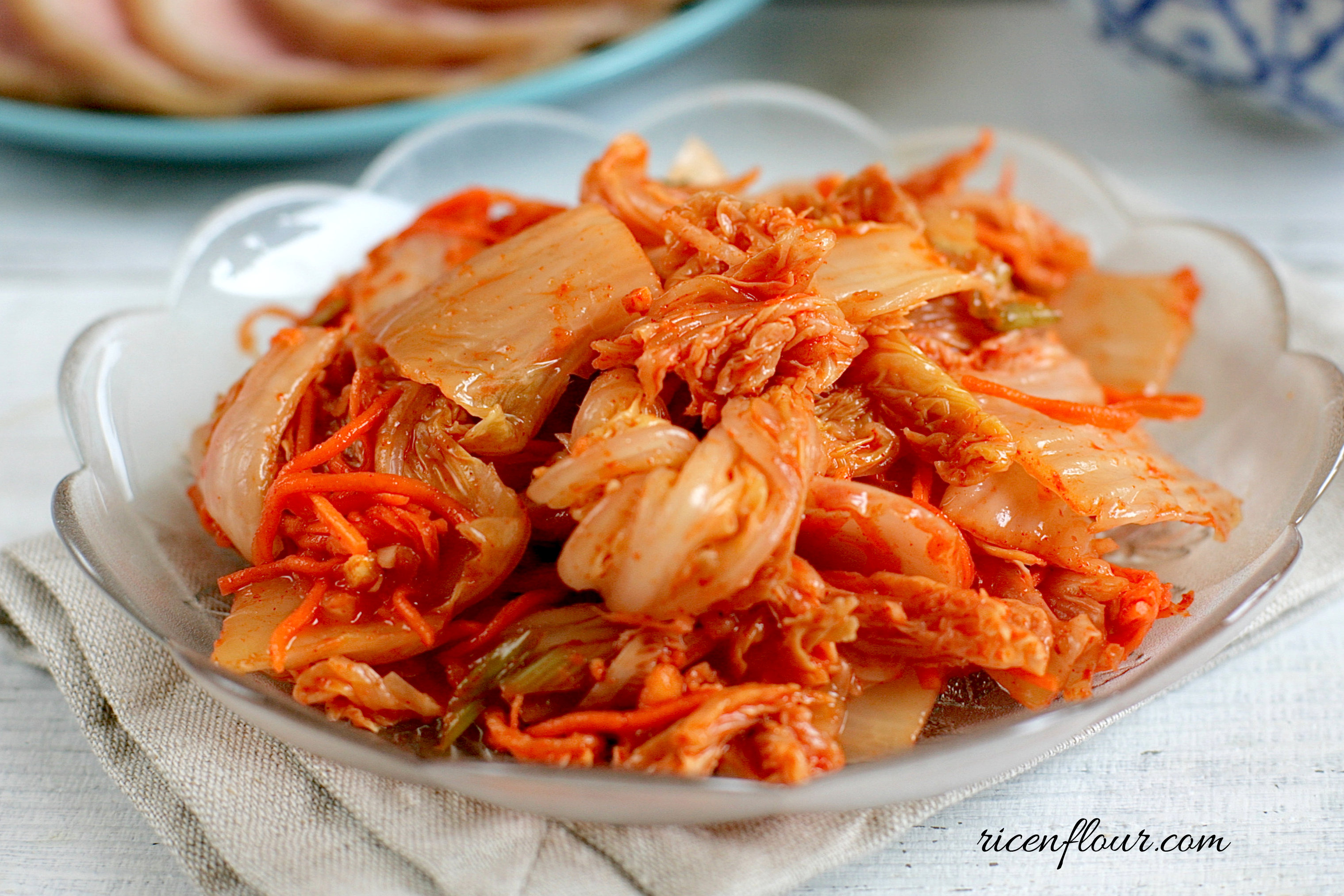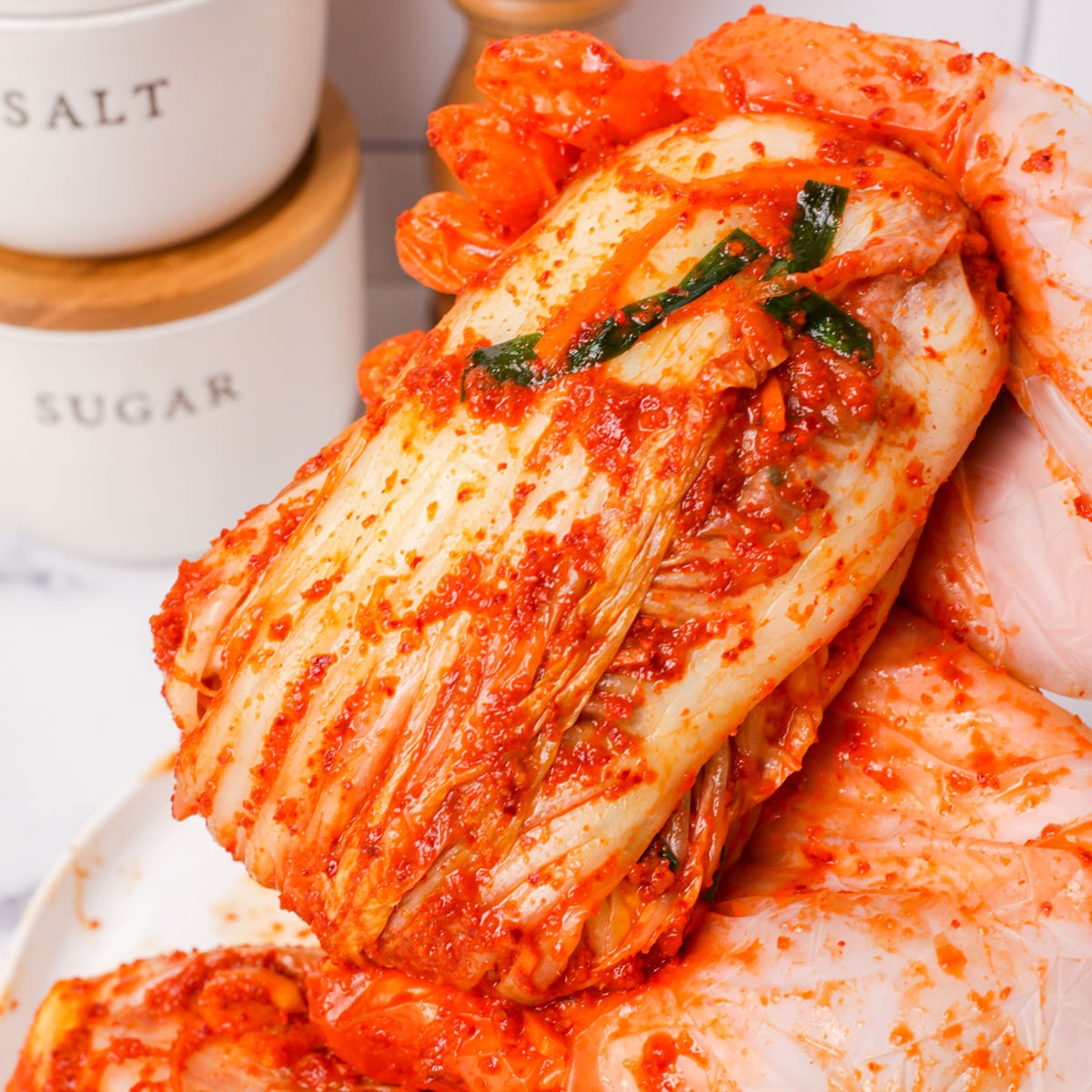ระเบียงภาพ [ แก้ ]
by Admin
Posted on 06-10-2023 12:31 PM

Afrikaans
العربية
অসমীয়া
فارسی
suomi
עברית
हिन्दी
ქართული
қазақша
ភាសាខ្មែរ
မြန်မာဘာသာ
nederlands
ئۇيغۇرچە / uyghurche
українська
บทความ
อภิปราย
เครื่องมือ
เครื่องมือ
ย้ายเมนูไปที่แถบด้านข้าง
ซ่อน
อ่าน
ทั่วไป
หน้าที่ลิงก์มา
การเปลี่ยนแปลงที่เกี่ยวโยง
อัปโหลดไฟล์
หน้าพิเศษ
ลิงก์ถาวร
สารสนเทศหน้า
get shortened url
อ้างอิงบทความนี้
สิ่งนี้ในวิกิสนเทศ
พิมพ์/ส่งออก
สร้างหนังสือ
ดาวน์โหลดเป็น pdf
รุ่นพร้อมพิมพ์
ในโครงการอื่น
วิกิมีเดียคอมมอนส์
วิกิตำรา
จากวิกิพีเดีย สารานุกรมเสรี
กิมจิ (คิมชี)
กิมจิร่วมสมัยรูปแบบต่าง ๆ
ชื่ออื่น
ฮันกึล
gimchi
kimch'i
ประเทศเกาหลี
กิมจิ ( เกาหลี : 김치; ราชบัณฑิตยสภา : คิมชี) เป็นของกินตามประเพณีใน อาหารเกาหลี ประกอบด้วย ผัก
เช่น
ผักกาดขาว และ หัวไชเท้า ที่หมักดองด้วยเกลือและเครื่องปรุงอื่น ๆ เช่น ผงพริกที่เรียก โกชูการู ต้นหอม กระเทียม ขิง และอาหารทะเลหมักเค็มที่เรียก ช็อตกัล มักรับประทานเป็น เครื่องเคียง แทบทุกมื้อ และมักใช้เป็นส่วนผสมในอาหารประเภทต้มและตุ๋น
กิมจินั้นมีหลายร้อยรูปแบบ ซึ่งทำด้วยผักที่ต่างกันออกไป ตามประเพณีแล้ว กิมจิมักเก็บไว้ในโอ่งดินขนาดใหญ่ที่เรียก องกี แล้วฝังไว้ใต้ดินเพื่อมิให้แข็งตัวในช่วงฤดูหนาว และเพื่อรักษาอุณหภูมิมิให้เน่าเปื่อยเร็วไปในช่วงฤดูร้อน โอ่งดังกล่าวบางทีก็เก็บไว้นอกบ้านตรงชานที่ทำขึ้นพิเศษ เรียกว่า ชังดกแด ส่วนในยุคปัจจุบัน หันไปใช้ ตู้แช่กิมจิ กันมากขึ้น
ระเบียงภาพ[ แก้ ]
กิมจิผักกาดขาว
คิมชีจีแก แกงทำจาก.

Etymology [ edit ]
Etymology[ edit ]
borrowed from korean 김치 (gimchi), ultimately composed within korea of chinese -derived morphemes 沉 (mc drim, “submerged, soaked”) and 菜 (mc tshojh, “vegetable”), i. E. "fermented vegetable". Doublet of kimuchi. Kimchi
kimchi (usually uncountable , plural kimchis )
a korean dish made of vegetables, such as cabbage or radishes, that are salted, seasoned, and stored in sealed containers to undergo lactic acid fermentation. , pocket books, page 238:
2007, pamela goyan kittler, kathryn sucher,
food
and culture
, cengage learning, page 5:
2011, gerald m.
 Weinberg,
cantonese: 泡菜 (paau3 coi3)
chinese:
nominative
possessive forms of kimchi (type risti)
first-person singular possessor
kimchi in wielki słownik języka polskiego, instytut języka polskiego pan
kimchi in polish dictionaries at pwn.
Weinberg,
cantonese: 泡菜 (paau3 coi3)
chinese:
nominative
possessive forms of kimchi (type risti)
first-person singular possessor
kimchi in wielki słownik języka polskiego, instytut języka polskiego pan
kimchi in polish dictionaries at pwn.
History [ edit ]
Fermentation has been part of human diet since the prehistoric times. Kimchi is a korean culinary tradition with a 1,500 year recorded history, developed as a means to preserve cabbage and other vegetables naturally through fermentation—like its distant cousin sauerkraut, or brined pickles. There is a certain mythical aura to kimchi if you ask any koreans. Long heralded as the “super food” of korea, many studies and findings in recent years associate kimchi’s unique attributes to numerous health benefits. Kimchi produces non-dairy probiotics, or “healthy bacteria,” that aids in digestion and building a healthy, balanced gut flora, which results in a stronger immune system .
2 medium heads napa cabbage (about 6-8 pounds total) 1 1/2 cups coarse salt, non-iodized, divided (baked or sea salt recommended) 1 gallon + 1/2 cup cold water, divided 2 tbsp. Sweet rice flour 1-10 cloves garlic, depending on taste preference about 3 slices fresh ginger root (about 0. 2-0. 4 oz. )1 cup korean red pepper powder –specific “for kimchi” 1/2 korean radish (about 1-1. 5 pounds), or daikon radish 1 asian pear (optional) recipe provided by hyojung kang, local kimchi expert, with edits by laura bauer, phd, rd, in collaboration with csu food science & human nutrition extension. For additional information, contact: marisa bunning, phd; associate professor and extension specialist-food safety: marisa.
See also [ edit ]
Avaliação: 4,2 (13 votos) 13 comentários por lucas lima , redator e editor no tudoreceitas. 29 julho 2019 o kimchi é considerado a "base da alimentação" dos coreanos, pode mesmo ser comparado ao arroz e feijão brasileiros porque ele nunca falta na mesa dos coreanos! mas o que é kimchi? continue aqui no tudoreceitas para saber mais sobre essa receita tradicional da coreia e sobre como fazer kimchi passo a passo em fotos. O kimchi, também chamado de "kim chi", "kimchee" ou "gimchi" é uma conserva de legumes fermentados (picles de legumes) que é preparada do mesmo jeito desde há 250 anos.
Dishes usually served with kimchi [ edit ]
In korean culture, kimchi is served with almost every meal, including breakfast. Not only is kimchi eaten by itself as a side dish or appetizer but it is also used as an ingredient in a variety of dishes. Kimchi jjigae , a traditional stew made with kimchi, is perhaps one of its most popular uses. The fermented food is also used to flavor fried rice, stir-fry dishes, noodles, sandwiches, and even pizza.
Miriam hahn/tasting table before you get started, you must make a list and head to the store. Pick up napa cabbage, pink himalayan salt, filtered water, carrots, radishes, scallions, grated ginger , minced garlic, fish sauce, red pepper flakes , and sugar. In addition to the foods, you'll also need supplies for the fermenting process. In this case, hahn notes that you'll need a 32-ounce mason jar, a wooden mallet, and a glass sauerkraut weight. She admits it's possible to get by without the specialized tools — for instance, if you don't have the sauerkraut weight, you can get away with using a large leaf of cabbage reserved from the head of cabbage you're fermenting — but says if you want to make kimchi regularly, it's best to invest in the appropriate fermenting tools.